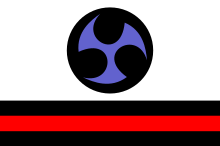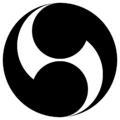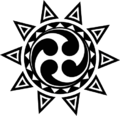Tomoe
A tomoe (巴 or 鞆絵, ともえ) and tomowe (ともゑ) in its archaic form, is a Japanese abstract shape described as a swirl that resembles a comma or the usual form of a magatama. The origin of tomoe is uncertain. Some think that it originally meant tomoe (鞆絵), or drawings on tomo (鞆), a round arm protector used by an archer, whereas others see tomoe as stylized magatama.[1] It is a common design element in Japanese family emblems (家紋 kamon) and corporate logos, particularly in triplicate whorls known as mitsudomoe (三つ巴). Some view the mitsudomoe as representative of the threefold division (Man, Earth, and Sky) at the heart of the Shinto religion. Originally, it was associated with the Shinto war deity Hachiman, and through that was adopted by the samurai as their traditional symbol. One mitsudomoe variant, the Hidari Gomon, is the traditional symbol of the Ryūkyū Kingdom. The Koyasan Shingon sect of Buddhism uses the Hidari Gomon as a visual representation of the cycle of life.
The two-fold tomoe is almost identical in its design elements to the Chinese symbol known as a taijitu, while the three-fold tomoe is very similar to the Korean tricolored taegeuk. Also note that the negative space in between the swirls of a four-fold tomoe, forms the shape of a stylized swastika, which is fairly prominent in many Indian religions such as Hinduism and Jainism. On the opposite side of Eurasia, the Basque lauburu and some forms of the Celtic spiral triskele resemble small groups of tomoe.
Gallery

 The flag of the Ryūkyū Kingdom featuring a mitsudomoe
The flag of the Ryūkyū Kingdom featuring a mitsudomoe Futatsudomoe, a two-fold tomoe
Futatsudomoe, a two-fold tomoe A Polish neopagan solar symbol resembling a fourfold tomoe
A Polish neopagan solar symbol resembling a fourfold tomoe
See also
References
External links
| Wikimedia Commons has media related to Tomoe. |
- Japan Emblem Library - tomoe design patterns (Japanese)
- JAANUS/ tomoemon
- The Shinto Trinity
- Aikido Sangenkai: Mitsu-domoe at the Kami-Shirataki Shrine